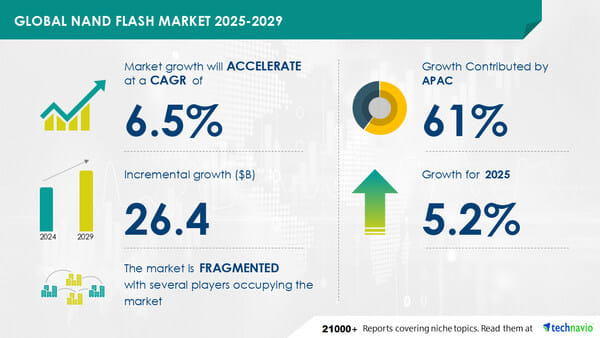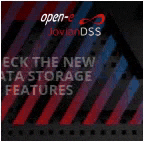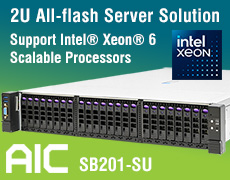NAND Flash Market to Grow by $26.4 Billion (2025-2029)
Boosted by investments in production with AI impacting market trends Technavio says
This is a Press Release edited by StorageNewsletter.com on February 4, 2025 at 2:01 pmTechnavio, a division of Infiniti Research Limited, has announced its latest market research report titled Global NAND Flash Market 2025-2029.

Summary
The global NAND flash market size is estimated to grow by USD 26.4 billion from 2025-2029.
The market is estimated to grow at a CAGR of almost 6.5% during the forecast period. Growing investments in fabrication facilities is driving market growth, with a trend towards rise in number of strategic partnerships and acquisitions. However, fluctuations in demand and supply poses a challenge.
Key market players include Adata Technology Co. Ltd., Flexxon Pte Ltd., Greenliant Systems, Hyperstone GmbH, Infineon Technologies AG, Innodisk Corp., Kingston Technology Co. Inc., Kioxia Corp., Macronix International Co. Ltd., Micron Technology Inc., Renesas Electronics Corp., Samsung Electronics Co. Ltd., Semiconductor Manufacturing International Corp., Shenzhen Longsys Electronics Co. Ltd., Silicon Motion Technology Corp., SK hynix Co. Ltd., Toshiba Corp., and Transcend Information Inc.
Market Scope
| Report Coverage | Details |
| Base year | 2024 |
| Historic period |
2019 – 2023 |
| Forecast period |
2025-2029 |
| Growth momentum & CAGR | Accelerate at a CAGR of 6.5% |
| Market growth 2025-2029 |
USD 26.4 billion |
| Market structure |
Fragmented |
| YoY growth 2022-2023 (%) | 5.2 |
| Regional analysis |
APAC, North America, Europe, South America, and Middle East and Africa |
| Performing market contribution | APAC at 61% |
| Key countries |
China, US, Japan, South Korea, Taiwan, Germany, Singapore, India, France, and Italy |
| Key companies profiled | Adata Technology Co. Ltd., Berkshire Hathaway Inc., Flexxon Pte Ltd., Greenliant Systems, Hyperstone GmbH, Infineon Technologies AG, Innodisk Corp., Kingston Technology Co. Inc., Kioxia Corp., Macronix International Co. Ltd., Micron Technology Inc., Renesas Electronics Corp., Samsung Electronics Co. Ltd., Semiconductor Manufacturing International Corp., Shenzhen Longsys Electronics Co. Ltd., Silicon Motion Technology Corp., SK hynix Co. Ltd., Toshiba Corp., Transcend Information Inc., and Udisys Ltd. |
Market Driver
The NAND flash market is experiencing significant trends in consumption, memory packaging, and fabrication facilities. High-density storage and 3D NAND technology are driving the demand for NAND flash in various industries such as tablets, cameras, sensors, automotive systems, medical devices, and electronics. NAND flash memory is essential for code, AI, and ML applications in consumer electronics.
NAND flash vendors are facing low supply and high demand, leading to supply shortages and rising costs. The industry chain is adapting to these challenges through purchase orders, optimized production strategies, and R&D. The growing demand for digital content, applications, and scalable storage capacities is making NAND flash memory an essential component in IoT ecosystems, handling massive datasets, and powering cloud service providers.
The market is also diversifying into new markets such as AR/VR devices, 8K video recording, digital health records, and medical imaging. NAND manufacturers are focusing on longer development cycles, optimizing production, and strategic market positioning to adapt to cyclical market shifts and economic changes. The broader semiconductor industry is also impacted by raw materials, production delays, and environmental challenges, requiring a holistic approach to risk management and sustainable future measures.
TrendForce reports that production capacity utilization is high, with chip makers and equipment manufacturers increasing production to meet demand. The semiconductor memory market is expected to grow, with NAND flash memory remaining a key player due to its speed, reliability, and flexibility. The market is also seeing advancements in high-capacity, fast storage products, including SSDs, memory cards, and the Micron 3500 SSD. These products cater to various industries, including automotive applications, cloud computing services, and 5G infrastructure.
In conclusion, the NAND flash market is experiencing in demand due to technological advancements and the reliance on NAND flash for multifunctional communication, entertainment, productivity tools, and data processing.
The industry is adapting to supply shortages and rising costs through strategic production strategies, R&D, and eco-friendly measures. The market is expected to remain a crucial component in the electronics sector, handling massive datasets, powering cloud computing infrastructure, and enabling diverse applications in various industries.
The NAND flash market is witnessing an increase in strategic partnerships and acquisitions, enabling vendors to expand their market presence. These collaborations allow companies to develop technological initiatives, such as the joint development of 3D NAND flash memory, and make capital investments according to market trends. For instance, Micron Technology’s partnership with 7 industrial companies in February 2020 aims to deliver innovative solutions for industrial applications, including factory automation, transportation, and defense systems, through the Micron IQ Partner Program. This collaboration strengthens the competitiveness of the involved parties and advances the development of high-quality, long-lasting NAND flash products.
Market Challenges:
- The NAND flash market is currently facing several challenges that are impacting both chip makers and equipment manufacturers. NAND flash consumption is growing rapidly due to the increasing demand for high-density storage in various industries such as tablets, cameras, sensors, automotive systems, medical devices, and electronics. This demand is driving the need for more advanced NAND technologies like 3D NAND and larger capacities in TLC segment, SLC, and MLC variants. However, the production capacity utilization is low due to supply shortages and rising costs. The industry chain is facing purchase orders that exceed supply, leading to price erosion and reduced profitability for NAND flash vendors. This situation is further complicated by cyclical market shifts, economic changes, and supply chain constraints. Moreover, technological advancements in areas like AI, ML, and cloud computing infrastructure require faster, more reliable, and scalable storage capacities. Modern consumers rely on NAND flash memory for web browsing, email loading, games, social network sites, 5G wireless communication, and multi-functional communication devices. NAND flash memory is an essential component in diverse industries, including AR/VR devices, 8K video recording, digital health records, medical imaging, wearable devices, innovative city initiatives, and environmental monitoring systems. As a result, NAND flash memory vendors must diversify their products and optimize production strategies to meet the growing demand and handle massive datasets in data centers and cloud service providers. To address these challenges, NAND manufacturers need to adapt to the cyclical pattern of the semiconductor memory market, invest in R&D, and implement longer development cycles to stay competitive. They must also focus on optimizing production, reducing production costs, and managing risks through strategic market positioning and adaptive production strategies. The broader semiconductor industry is also facing challenges, including raw materials, production delays, increased costs, environmental challenges, and sustainability concerns. NAND flash memory vendors must address these challenges to ensure a sustainable future and eco-friendly measures in the industry. In summary, the NAND flash market is facing significant challenges due to growing demand, supply shortages, rising costs, and technological advancements. NAND flash vendors must adapt to these challenges through innovation, R&D, and strategic market positioning to maintain their global market dominance and meet the demands of enterprise use and storage solution providers.
- The NAND flash market experiences a significant challenge due to the widening demand-supply gap. This issue arises from the cyclical nature of the semiconductor industry, which affects the production and sales of NAND flash. The market relies on demand from industries such as smartphones, data centers, servers, cloud storage, and consumer electronics. Vendors attempt to align production with sales in these sectors, but unexpected changes in demand can result in oversupply or shortages. The dynamic semiconductor industry, influenced by consumer electronic demand fluctuations, emerging technologies, and manufacturing process changes, contributes to the persistent supply-demand imbalance.
Smartphones
The global NAND flash market is experiencing growth due to several factors. The increasing penetration of the Internet and the widespread use of low-cost smartphones are driving the generation of large volumes of data, including audio, video, text, and encrypted blocks. Social media applications, such as Facebook, WhatsApp, and Instagram, are popular among users, leading to the storage of vast amounts of data by these companies. The adoption of high-resolution camera modules in smartphones for capturing selfies and recording videos is also contributing to the demand for NAND flash. The implementation of 4G and 5G networks and the use of AI in smartphone applications are further increasing the volume of data generated and stored in smartphones. Technavio expects smartphone manufacturers to incorporate multiple-lens camera systems, leading to an increased demand for high-capacity memory modules. All these factors are expected to fuel the growth of the NAND flash market during the forecast period.
Research Analysis
NAND flash consumption continues to soar, driven by the insatiable demand for high-density storage in consumer electronics. Memory packaging and fabrication facilities are working at full capacity to meet this demand, with a focus on 3D NAND technology to increase storage density. Edge storage and high-density data centers also contribute significantly to NAND flash market growth. Chip makers and equipment manufacturers collaborate to ensure a steady supply of NAND flash memory, but the industry faces a challenging balance between low supply and high demand. TrendForce reports that production capacity utilization remains high, reflecting the reliance on NAND flash memory in modern consumer devices such as tablets and cameras. Technological advancements in NAND flash memory are expected to further fuel demand, making it a key player in the semiconductor memory market.
Market Research Overview
NAND flash consumption continues to soar in the electronics device sector, fueled by the growing demand for high-density storage, edge storage, and 3D NAND. Memory packaging and fabrication facilities are working at full capacity to meet the insatiable appetite for flash memory. NAND flash is increasingly used in tablets, cameras, sensors, automotive systems, medical devices, processors, and various digital applications. Modern consumers rely on NAND flash memory for web browsing, email loading, games, social network sites, 5G wireless communication, and more. The semiconductor memory market, led by NAND flash, is expected to grow due to technological advancements and the increasing importance of storage in diverse industries.
TrendForce reports that production capacity utilization is high, leading to supply shortages and rising costs for NAND flash. The industry chain is facing challenges due to low supply and high demand, which is impacting purchase orders and causing industry-wide disruptions. NAND flash memory is an essential component of cloud service providers, handling massive datasets and offering speed, reliability, and flexibility. Advancements in storage capacities and performance are driving innovation and development in the broader semiconductor industry. The NAND flash market is cyclical, with economic conditions, disposable incomes, and market demands influencing its pattern. NAND manufacturers are diversifying their products and optimizing production strategies to adapt to cyclical market shifts and economic changes. Despite challenges such as supply chain constraints, natural disasters, and global events, the future of NAND flash looks promising, with a focus on sustainability, eco-friendly measures, and longer development cycles. The market is expected to continue its growth trajectory, driven by the increasing importance of storage in various industries and the need for scalable storage capacities.
About Technavio
Technavio is a global technology research and advisory company. Their research and analysis focuses on emerging market trends and provides actionable insights to help businesses identify market opportunities and develop effective strategies to optimize their market positions.
Request Sample of report to stay ahead in the AI-driven market evolution! (registration required)













 Subscribe to our free daily newsletter
Subscribe to our free daily newsletter

